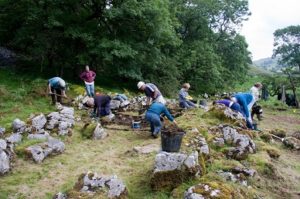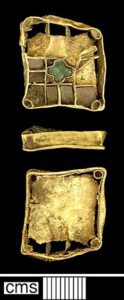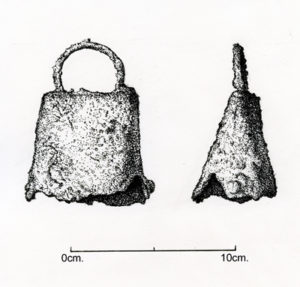David Johnson’s research over many years is in truth ground breaking (in more ways than one!) and will be a revelation to those in the south who think the Angles and Saxons only occupied the southern half of England. He outlined the geographical context, discussed Early Mediaeval (EM) sites, the proven evidence and the issues and implications arising from the findings.
As David stated the Anglo Saxons were present here inbetween the control freaks who were the Romans and the Normans. The EM period was pre Norman Conquest.
He began his talk by discussing the origin of place names by saying that they were not point specific. Despite 60% of place names in some areas of the Dales being of Norse or Viking derivation, this did not hold true for major settlement names. In any case these were not recorded before Domesday. Much of the place names are hybrid old Norse and old English. However, he was at pains to point out that presently the evidence is lacking to prove the Norse men were here at this time in the Dales.
Recent archaeological excavation sites included Selside, Chapel-le-Dale, Austwick and Clapham. Of course archaeologists need evidence and on some sites like Crummuckdale, Austwick there was evidence galore – a veritable hoard. Amongst the finds in the areas overall were a work box, knife, beads, whet stones, smithing tongues, haematite, a piece of green glass with a molded rim and part of a horses bridle and sheep bell. All sites lacked evidence of pottery. Secure statistical dating from radiocarbon evidence of charcoal, bone and hazelnuts places occupation from between AD 600-700 to 1015 (apart from one at Top Cow Pasture at 1215). Radiocarbon dating of bone from a female burial was firmly within the Anglo Saxon Period and human bone from other earlier excavations shows dates compatible with Anglo Saxon settlement.

Excavations at Chapel-le-Dale. Courtesy of David Johnson

Early-Medieval (Anglo-Saxon) Belt Mount. Treasure case no. 2004 T187. Found Isle of Wight. Attribution: Share Alike
With regard to the excavated foundations of the buildings, all were made of limestone and without exception had double skinned dwarf walls. It is thought that the walls were then highered by the addition of turf which might have been timber lined. What seems to be of considerable interest is that a southern chap called Blair developed something known as a ‘four perch model’ where a measured grid is put over the plans of buildings and enclosures and the same shows a ‘fit’ when applied to other sites in the south. Interestingly when this model is placed over the excavations in Craven the grid fits almost perfectly in some areas, less so in others. By inference this also demonstrates adoption of a common building template over several centuries and the possible transference of this method from one Anglo Saxon territory to another, although there is more work and discussion needed here.
All the sites he mentioned were at 300M above sea level on limestone. All sites were said to be vacated by 1015 except one and it was thought that people moved down to larger settlements, perhaps due to climate change, there is no hard evidence for this though and the motives behind the shift have yet to be determined. It is interesting that these northern Anglo Saxons in these early mediaeval years are not the peasants that we supposed them to be, they owned objects of status for example the green glass, horse bridle, chatelaine, silver sword pommel, bronze belt fittings.

Sheep Bell. Courtesy of David Johnson.
Lots of questions were answered through these patient and thorough excavations and assessment of the findings which as David stated have led to the need for an overhaul or reassessment of what is thought of the the presence and lives of the Anglo Saxons in the whole of England. It appears that David’s work and findings will be of significance to future historians and archaeologists and society as a whole and we were lucky to secure him as a speaker.
This was an excellent talk and if you want to know more David’s latest book ‘New Light on the ‘Dark Ages’ in North Craven‘, is available in the shop at Pendle Heritage Centre, priced £8.
And did you know?
During the excavations 593 Mole hills were sieved in all sorts of weather with no finds to show at all….
One door step had placed deposits thought to demonstrate ritual beliefs.
It is supposed that the Anglo Saxons used their horses for riding as opposed to work or draught horses.
That the bell weather sheep was a castrated male who had the bell hung round his neck, and steered the flock on its daily wanderings.
Banner Image:West Stow Anglo Saxon Village. Attribution:Midnightblueowl. Its not in North Craven but does give an idea of what Anglo Saxon homesteads looked like in the south.